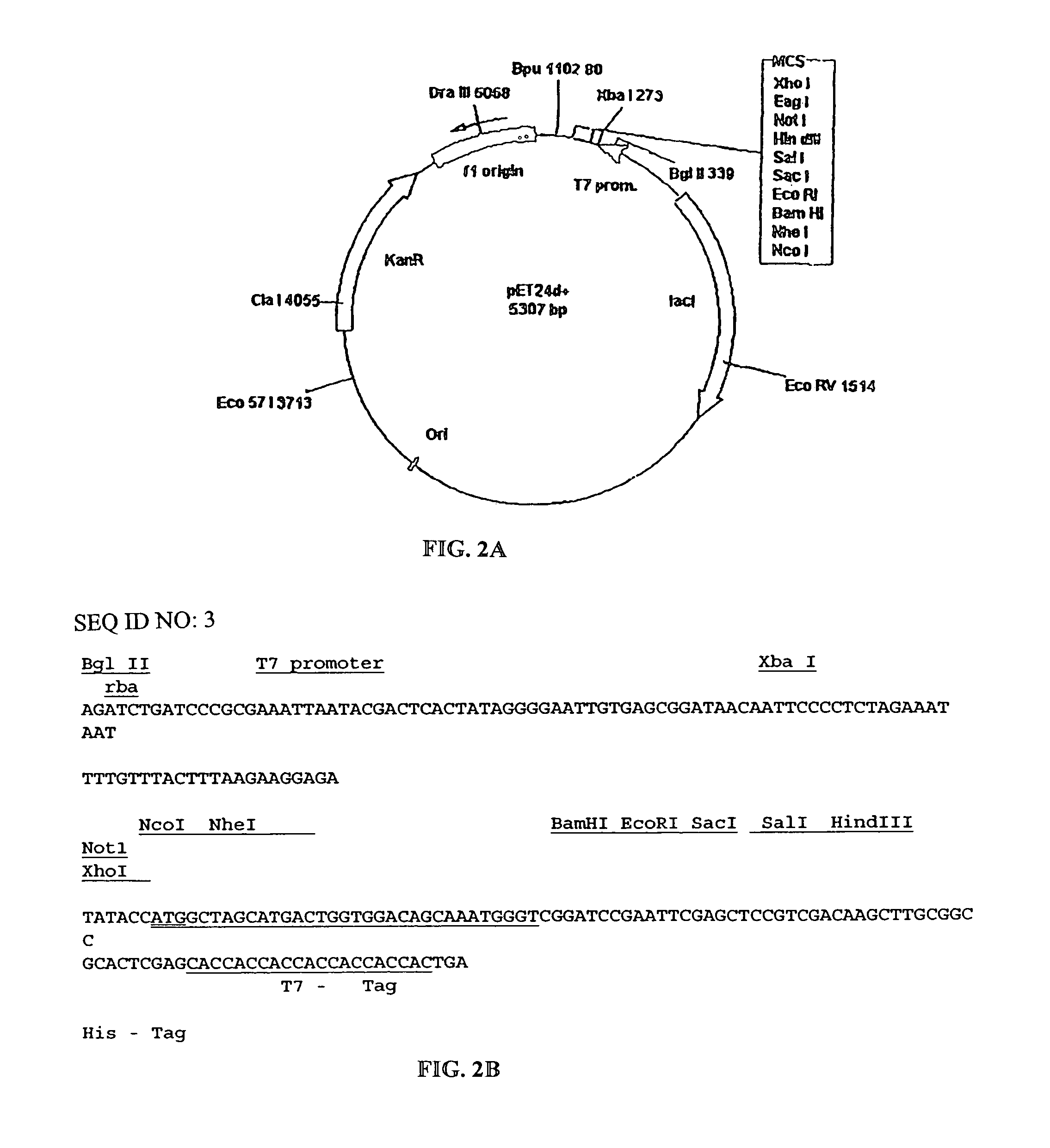Methods and compositions for diseases associated with amyloidosis
a technology of amyloidosis and composition, applied in the field of detection, treatment or prevention of amyloidosis or amyloid-associated diseases, can solve the problems of difficult diagnosis of alzheimer's before death, unable to develop therapies or other treatments for alzheimer's, and affecting vital functions
- Summary
- Abstract
- Description
- Claims
- Application Information
AI Technical Summary
Benefits of technology
Problems solved by technology
Method used
Image
Examples
example 1
Protein Sequence Analysis of the 6C6 Antibody Light Chain (VL)
[0067]The monoclonal antibody 6C6 (Athena Neurosciences, San Francisco, Calif.) recognizes an epitope located in the 1-16 region of β-amyloid and is capable of solubilizing β-amyloid fibers and tangles in vitro. See Tamaoka et al. 1992, Proc. Natl. Acad. Sci, USA, 89, 1345–9.
[0068]Light and heavy chains of 6C6 were separated under reducing conditions in an agarose gel. An in-gel Lys-C-digestion with Trypsin was performed on the Kappa light chain using 1 mg Lys-C overnight. Fractions were separated by reverse phase chromatography (HP-C90-1-IPLC 1 mm×12.5 cm, DAD-detector). The mass of collected fractions was determined by mass spectrometry (MALDI-TOF). N-terminal sequencing was performed using a PE-Biosystems-sequencer (Procise ABI 492, Langen, Gemany). Other fragments were obtained by in-gel digests with the endoprotease V-9 cleaving C-terminal of Glu. Peptides were sequenced starting at the N-terminus. The sequence of th...
example 2
Gene Synthesis and Cloning of the V Region of the Light Chain (VL)
[0069]The amino acid sequence of the fragment VL was converted into a nucleotide SEQ ID NO: 1 and inserted into an appropriate vector system. SEQ ID NO:1 includes a methionine residue at position 0 as well as the leucine and glutamine residues at position 109 and 110 as a result of the cloning strategy. The actual DNA sequence of the VL chain corresponds to SEQ ID NO:4. The VL gene fragment was synthesized using a PCR-based approach. The sequences of the sense and anti-sense strands were divided approximately into 25 nt oligonucleotides at the 5′-end (external oligo) followed by four 50 mers (internal oligo) in a gapless manner. Internal oligonucleotides were mixed and used as template in a PCR with the two external 5′-oligos as primers, in a 100-fold excess. PCR was performed in 50 μl volume using 1 unit of a proof-reading polymerase (Ultma, Perkin-Elmer) with 2 mM MgCI2, buffers as supplied by the manufacturer and 2...
example 3
Expression in E. Coli
[0071]E Coli B21 (DE3)pLysS were transformed with the plasmid pETVL102 (pETVL112) and the empty vector pET24d+ (pET36b+) as a control. Overnight cultures were used to inoculate 50 ml of LB-medium containing 50 μg / ml kanamycin and 30 μg / ml chloramphenical. Cultures were grown at 37° C. for 2 hours and agitated at 200 rpm. Expression was induced by the addition of IPTG (final concentration 0.5 mM). 2 ml samples were taken after 2 hours and 4 hours and centrifuged (5 min, 1600×g, 4° C.). The pellets were washed with 1 ml of TrisHCI buffer (25 mlM, pH=7.5) and dissolved in 200 μl of 1×SDS gel-loading buffer (RotiLoad 1, Carl Roth). The samples were sonicated, heated (5 minutes, 95° C.) and analyzed on a 15% SDS-PAGE.
[0072]In a subsequent step, expression of the VL-fragment in pETVL112 was repeated on a 2.5 L scale. The total soluble cell fractions were subjected to immobilized nickel affinity chromatography (Ni-1MAC) in a FPLC system. A column of Chelating Sepharos...
PUM
| Property | Measurement | Unit |
|---|---|---|
| volume | aaaaa | aaaaa |
| mass | aaaaa | aaaaa |
| elution volume | aaaaa | aaaaa |
Abstract
Description
Claims
Application Information
 Login to View More
Login to View More - R&D
- Intellectual Property
- Life Sciences
- Materials
- Tech Scout
- Unparalleled Data Quality
- Higher Quality Content
- 60% Fewer Hallucinations
Browse by: Latest US Patents, China's latest patents, Technical Efficacy Thesaurus, Application Domain, Technology Topic, Popular Technical Reports.
© 2025 PatSnap. All rights reserved.Legal|Privacy policy|Modern Slavery Act Transparency Statement|Sitemap|About US| Contact US: help@patsnap.com



